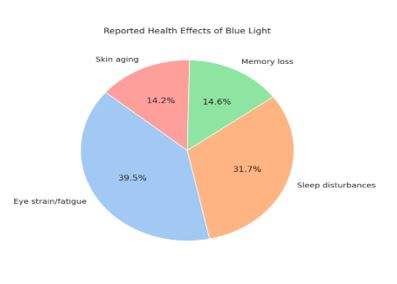
Background and Objective: The common usage of blue light-emitting devices has caused tremendous concern over their impact on eye health and sleep quality, particularly among college students. The purpose of this study is to evaluate the knowledge, attitude, and practice (KAP) about blue light exposure and use of filters among students of Srinivas College of Pharmacy, Mangalore.
Methods: An institutional cross-sectional study was done among 200 students with the help of a structured questionnaire. Information gathered included screen time, knowledge of the effect of blue light, use of preventive strategies such as blue light filters and the 20-20-20 rule, and the prevalence of eye strain and sleep disturbance.
Results: The majority of students (63.6%, 95% CI: 56.8–70.0%) had no knowledge of the health effects of blue light. Notwithstanding this, 44.3% (95% CI: 37.3–51.5%) had more than 7 hours of daily screen exposure. Eye strain was complained of by 64.7% (95% CI: 57.8–71.1%), and 70% (95% CI: 63.3–76.0%) had sleep problems. Blue light filters were used by only 20% (95% CI: 14.8–26.3%), and 38% (95% CI: 31.4–45.0%) followed the 20-20-20 rule. Although 73.6% (95% CI: 67.0–79.4%) were concerned about blue light, the uptake of preventive behaviors was low.
Conclusion: The research identified a wide gap between concern and actual preventive behavior towards blue light exposure among students. There is a critical need for educational interventions to create awareness and promote healthier digital device use habits to safeguard eye health and enhance sleep quality.
Keywords: Blue light exposure, eye strain, sleep disturbances, preventive practices, college students
Ranjan K, Ramdas B. Institutional Cross-Sectional Study on Student Knowledge, Attitude, and Practice of Blue Light Filters and Eye Health. Oral Sphere J Dent Health Sci. (2025); 1(3): 156-165. https://doi.org/10.63150/osjdhs.2025.13